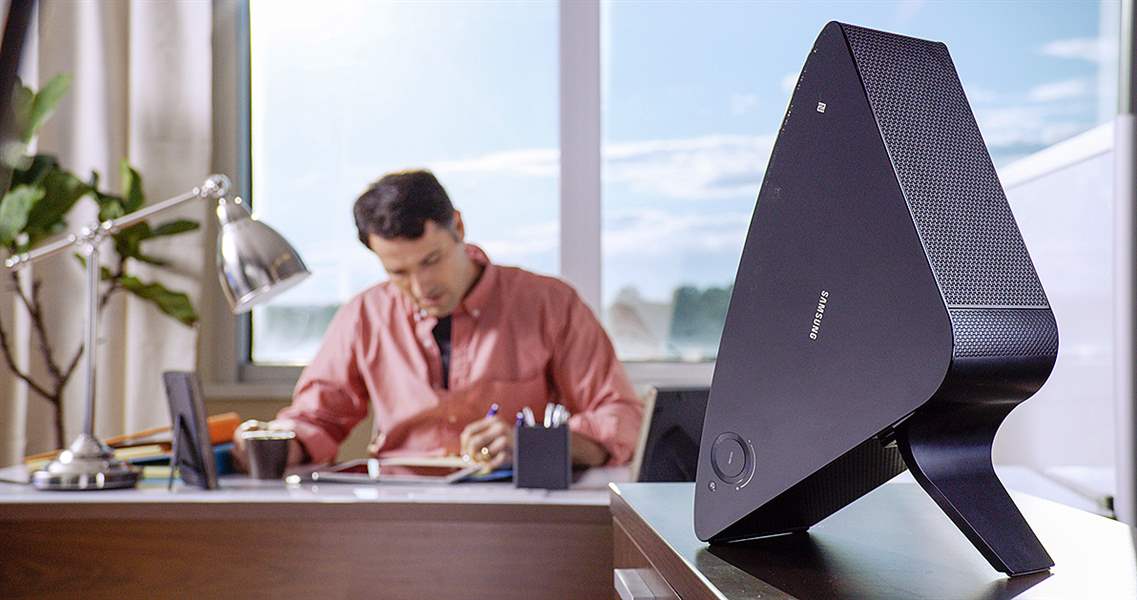
Big sound comes in small, portable speaker packages
12/21/2013
Newer models of wireless speakers — such as the Samsung Shape M7 unit above — deliver sound that can satisfy a demanding listener and do it from relatively small packages.
SAMSUNG

You may have noticed the spate of new wireless audio speakers on the market, many of them marketed to be sold in multiples and placed throughout the house.
For the speaker companies, it isn’t all about function and audio science: Their priority is to sell you five or six speakers at a time.
Your priority should be to figure out what you want from music.
I’m a music critic who often travels long distances to hear something live but does not want recorded music, and especially the devices that play it, to gain ground on me. (I want to play it, not the other way around.)
I’m skeptical about speakers the size of small monuments. I think kids who listen to music on their cell phones or through laptop speakers are expressing an authentic use of music in their lives. I’m used to better sound than that. But my basic attitude toward new audio equipment is condescension.
So I understand what I do not want. But what do I want? For the record, wireless speakers — unless we’re talking about smaller, portable-by-design, Bluetooth-enabled ones that can be battery operated like Jawbone’s Jambox or Grain Audio’s new Packable model — are not truly wireless. The options with fuller sound — the kind I’m looking for — need to be plugged into the wall.
Still, they do not need wires to connect to the source of the music, preventing a permanent state of cord spaghetti. The simplicity and reduced size of many of the new wireless speakers make sense to me. They are easy to move physically and boss around mechanically, usually with simple controls on a smart phone. I like the idea of shifting my speakers to another place or banishing them from my sight, when I want to.
With wireless speakers, especially smaller ones, this is reasonable. Multiroom wireless systems, with speakers placed in as many rooms as you like, bring on different concerns.
Until recently, I saw only three uses for them. One was to become a crisper family autocrat. (We will now all, in different rooms, listen to my No. 1 record of the year.)
Another was to help with hearing podcasts, so you don’t forget where you are in someone’s run-on sentence while you move from the living room to the kitchen. And the third was to help you imagine that you live in a department store, where your ambulatory shopping experience is an unbroken soundtrack.
But my family and I just moved, and I’ve been rethinking the audio question down to the root.
Maybe there’s more to it than I thought. My rethinking really started when I got my hands on the wireless Sonos speakers. The company’s speakers have been justifiably popular since 2009, when it introduced what is now called the Play:5 speaker: $400 and roughly 8 inches by 14 inches, a rectangle that sits on its long end.
To use the speakers, you plug the company’s Bridge component (roughly $50) into your router or Mac AirPort Express. This passes wireless signals to the speakers. You place the speakers where you want them in the house, then download the Sonos app into your various smart phones or computers.
Each device can choose which speakers to play through, and draw from the same family well of music. (It can play from iTunes and several other music services including the popular streaming service Spotify, if you have Spotify’s premium subscription.)
When you listen through iTunes, all the different iTunes libraries in the house combine into one large Sonos library.
You don’t have to look at the larger library, but you can. My children may not choose to listen to what lies outside their own iTunes collection, but the family holdings are easily accessible to them like one communal record shelf. That's good.
The newest Sonos model is the Play:1 ($200), introduced in October. It’s smaller and lighter than the Play:5 or the intermediate Play:3 ($300). Sitting vertically, at 6 ½ inches tall, and with rounded edges, the Play:1 looks something like a wide-mouth Mason jar. It sounds almost unreasonably rich, much more than its size would indicate.
Samsung has its own multiroom wireless system to go against Sonos: the Shape M7, at $360, with wedge-shaped speakers comparable in size to Sonos’ Play:5 and its own central wireless station to connect to your router, called a Hub, which costs about $50.It’s not the same. The app is downloadable only to Android or iOS equipment. (If one of your main links to your music is a PC, you’re out of luck.) There’s a small but grating delay between selecting a song and hearing it come out of the speakers, something I have not experienced with the Sonos system.
The sound? It’s fine. But not great. Someone who hasn’t had much experience with listening to music over proper speakers at home might love it, especially if that person already has a Samsung phone. Older ears may be unimpressed.
Then there are the speakers offered by Korus, which work on a simpler but in some ways more problematic system. You plug a wireless device called a Baton into a computer or cell phone, and that becomes a kind of antenna for the speakers. The manual says that the Baton’s range is 65 feet; I put a speaker on the other end of our apartment, perhaps 40 feet away down a winding hallway, and heard the sound at the same quality as when the speaker sat 5 feet from the Baton.
The speakers are portable: wedge-shaped, with rounded handles on the back, so you can walk around with one like a lunchbox.
And you don’t need to bother with any router. They can be plugged in, or powered with six D batteries. So: car trips, hotels, beaches. Just a smart phone and one of these.
There is no communal library here. (There is nothing to download except a simple volume control app for up to four speakers.) You’re not getting a direct feed from any application in particular. What is coming out of your computer as a whole — Spotify, iTunes, YouTube, whatever — will be heard on the speakers.